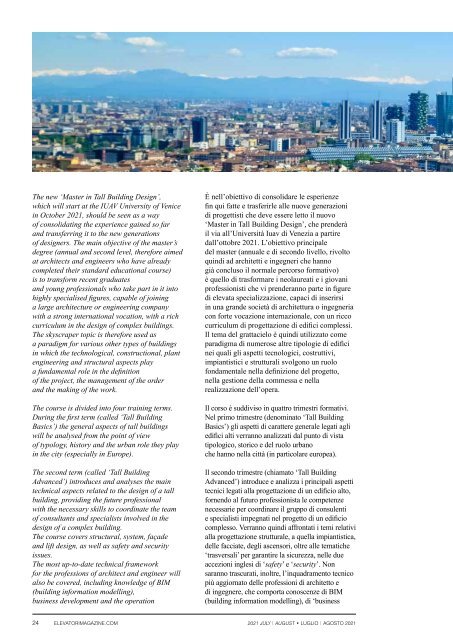You also want an ePaper? Increase the reach of your titles
YUMPU automatically turns print PDFs into web optimized ePapers that Google loves.
The new ‘Master in Tall Building Design’,<br />
which will start at the IUAV University of Venice<br />
in October <strong>2021</strong>, should be seen as a way<br />
of consolidating the experience gained so far<br />
and transferring it to the new generations<br />
of designers. The main objective of the master’s<br />
degree (annual and second level, therefore aimed<br />
at architects and engineers who have already<br />
completed their standard educational course)<br />
is to transform recent graduates<br />
and young professionals who take part in it into<br />
highly specialised figures, capable of joining<br />
a large architecture or engineering company<br />
with a strong international vocation, with a rich<br />
curriculum in the design of complex buildings.<br />
The skyscraper topic is therefore used as<br />
a paradigm for various other types of buildings<br />
in which the technological, constructional, plant<br />
engineering and structural aspects play<br />
a fundamental role in the definition<br />
of the project, the management of the order<br />
and the making of the work.<br />
The course is divided into four training terms.<br />
During the first term (called ‘Tall Building<br />
Basics’) the general aspects of tall buildings<br />
will be analysed from the point of view<br />
of typology, history and the urban role they play<br />
in the city (especially in Europe).<br />
The second term (called ‘Tall Building<br />
Advanced’) introduces and analyses the main<br />
technical aspects related to the design of a tall<br />
building, providing the future professional<br />
with the necessary skills to coordinate the team<br />
of consultants and specialists involved in the<br />
design of a complex building.<br />
The course covers structural, system, façade<br />
and lift design, as well as safety and security<br />
issues.<br />
The most up-to-date technical framework<br />
for the professions of architect and engineer will<br />
also be covered, including knowledge of BIM<br />
(building information modelling),<br />
business development and the operation<br />
È nell’obiettivo di consolidare le esperienze<br />
fin qui fatte e trasferirle alle nuove generazioni<br />
di progettisti che deve essere letto il nuovo<br />
‘Master in Tall Building Design’, che prenderà<br />
il via all’Università Iuav di Venezia a partire<br />
dall’ottobre <strong>2021</strong>. L’obiettivo principale<br />
del master (annuale e di secondo livello, rivolto<br />
quindi ad architetti e ingegneri che hanno<br />
già concluso il normale percorso formativo)<br />
è quello di trasformare i neolaureati e i giovani<br />
professionisti che vi prenderanno parte in figure<br />
di elevata specializzazione, capaci di inserirsi<br />
in una grande società di architettura o ingegneria<br />
con forte vocazione internazionale, con un ricco<br />
curriculum di progettazione di edifici complessi.<br />
Il tema del grattacielo è quindi utilizzato come<br />
paradigma di numerose altre tipologie di edifici<br />
nei quali gli aspetti tecnologici, costruttivi,<br />
impiantistici e strutturali svolgono un ruolo<br />
fondamentale nella definizione del progetto,<br />
nella gestione della commessa e nella<br />
realizzazione dell’opera.<br />
Il corso è suddiviso in quattro trimestri formativi.<br />
Nel primo trimestre (denominato ‘Tall Building<br />
Basics’) gli aspetti di carattere generale legati agli<br />
edifici alti verranno analizzati dal punto di vista<br />
tipologico, storico e del ruolo urbano<br />
che hanno nella città (in particolare europea).<br />
Il secondo trimestre (chiamato ‘Tall Building<br />
Advanced’) introduce e analizza i principali aspetti<br />
tecnici legati alla progettazione di un edificio alto,<br />
fornendo al futuro professionista le competenze<br />
necessarie per coordinare il gruppo di consulenti<br />
e specialisti impegnati nel progetto di un edificio<br />
complesso. Verranno quindi affrontati i temi relativi<br />
alla progettazione strutturale, a quella impiantistica,<br />
delle facciate, degli ascensori, oltre alle tematiche<br />
‘trasversali’ per garantire la sicurezza, nelle due<br />
accezioni inglesi di ‘safety’ e ‘security’. Non<br />
saranno trascurati, inoltre, l’inquadramento tecnico<br />
più aggiornato delle professioni di architetto e<br />
di ingegnere, che comporta conoscenze di BIM<br />
(building information modelling), di ‘business<br />
24 ELEVATORIMAGAZINE.COM <strong>2021</strong> JULY | AUGUST • LUGLIO | AGOSTO <strong>2021</strong>














